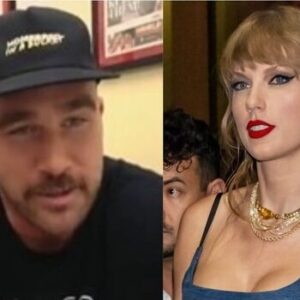Taylor Swift called ‘1989’ her 1st ‘official pop album.’ Why experts say it was the right time for her to leave country music.
The power of Taylor Swift seems to know no bounds. A fine example of that, say experts, is her seamless transition from country to pop music. (Getty Images)
It’s here: the release of 1989 (Taylor’s Version), a “rerecord” of Taylor Swift’s seminal 2014 album, debuting five new tracks that were left on the cutting-room floor.
Launched after her highly publicized breakup with Harry Styles, 1989 marked the beginning of Swift’s transition from country singer to pop music superstar, as it was billed as her “first documented, official pop album.”
The 1989 era was a defining period in Swift’s life, and experts say there’s more to the story than meets the eye.
Country roads to pop culture highways
Katherine Jeng, who recently taught the Taylor Swift Lyrical Evolution course at Rice University, credits Swift’s move from early country albums (Taylor Swift, Fearless, Speak Now and Red) to the unapologetic pop anthems that followed in 1989 — with hits like “Shake It Off,” “Blank Space” and “Bad Blood” — with having larger implications on how fans consume music.
“Taylor Swift’s departure from country has left its mark on the genre, which has led to the evolution of the country genre we see today,” she tells Yahoo Entertainment, adding that Swift’s transition saw the artist delivering “newfound creative freedoms over her music and career.”
That’s evident even before 1989, musicologist Nate Sloan notes, pointing out that Swift’s “We Are Never Ever Getting Back Together” song from Red exemplifies her intentional pivot from country to pop.
“The sonic landscape of the song swaps out banjos and violins for buzzing synths and electronic drumbeats,” Sloan tells Yahoo Entertainment.
She even went so far as to adopt the songwriting vocabulary of the pop genre by adding a section called a “post-chorus” (the wordless section when she sings “ooh-ooh-ooh-ooh-ooh yeah”), a common pop technique that’s “relatively rare in country,” he explains.
By the time 1989 was released, songs like “New Romantics” reflected a new Swift that embraced pop stylings within her music while also respecting the foundation her fans had come to know her for. Jeng says that allowed for a more seamless transition.
“‘New Romantics’ is meant to satirize the image of Taylor Swift that the public and media has,” she explains. “Swift is leaning into her public perception and fully accepts her transition to pop here. It’s a fun, upbeat song but also toes the line with dark, masterful lyrics.”
Old Swifties came along for the ride, with new fans swiftly joining
The shift also broadened Swift’s audience, Sloan says. At the same time country music fans tagged along in the transition, new Swifties were beginning to blossom in the pop culture scene who may not have connected with her otherwise. Still, it wasn’t an overnight success.
“Many of Swift’s country fans initially wrote her off after her pop transition, complaining that her interest in the genre must have been a commercial gambit rather than an authentic love for the style,” Sloan explains. “But the lasting impact of her country music oeuvre eventually spoke for itself.”
Regardless, the 2014 album was the biggest in Swift’s career, according to Billboard, having sold nearly 1.3 million copies in the first week (the largest sales week for an album in over a decade), and spent five nonconsecutive weeks at No. 1 on the Billboard 200 charts.
The added accolades — including Album of the Year and Best Pop Vocal Album at the 2016 Grammys — created more buzz for the artist amid her transition, which Jeng says allowed for more “radio play” and ultimately showed her to “be a versatile and evolving artist.”
The timing was everything
Going from country to pop isn’t easy, which Swift acknowledged in a 2019 interview with Billboard by saying that “crossing over to pop” was a “completely different world.”
“Country music is a real community, and in pop I didn’t see that community as much,” she said at the time, crediting country singers like Faith Hill with helping her forge a path in the scene. “Now there is a bit of one between the girls in pop — we all have each other’s numbers and text each other — but when I first started out in pop it was very much you versus you versus you. We didn’t have a network, which is weird because we can help each other through these moments when you just feel completely isolated.”
Swift performs on New Year’s Eve 2014 in Times Square in New York City. (Astrid Stawiarz/Getty Images for Moet & Chandon)
That’s not to say numerous others haven’t successfully made the transition out of country, and vice versa — Dolly Parton, Reba McEntire, Carrie Underwood, Kacey Musgraves and Lil Nas X, to name a few. But Sloan says Swift’s journey happened at the right place at the right time.
At the time, country music was beginning to popularize what’s known as “bro country,” a subgenre that emerged in the 2010s and a term coined by music critic Jody Rosen, characterized by its focus on young men and lyrics about partying, women, rural life and pickup trucks (like Florida Georgia Line’s “Cruise” from 2012).
Over on the pop side, Sloan explains, the industry was beginning to make room for “more complex female voices” like Swift, Miley Cyrus, Selena Gomez and Demi Lovato after “hypersexualizing artists such as Britney Spears during the decade of the 2000s.” And audiences were ready.
Unlike Garth Brooks, Sloan points to as an example, who unsuccessfully tried to transition to rock with his Chris Gaines alter ego in 1999, which ended up being a “commercial flop and a critical failure,” Swift had an intentional strategy going in.
“Her decision to collaborate with proven hitmakers, like [producer] Max Martin, helped her navigate the tricky transition from the hermetic world of country to the mirror ball world of pop,” says Sloan.
An ever-changing Taylor multiverse
The upcoming album is Swift’s fourth rerecord, following Fearless (Taylor’s Version) and Red (Taylor’s Version), both of which dropped in 2021, and Speak Now (Taylor’s Version), which dropped in July of this year.
Swifties are growing beyond just the music scene as well. In the wake of her new relationship with NFL player Travis Kelce, countless sports fans have hopped onto the Taylor train. Not to mention, her Eras concert movie brought in over $100 million this month, further proving her box-office appeal.
Taylor Swift and Brittany Mahomes at the Chargers-Chiefs game at Arrowhead Stadium in Kansas City, Mo., on Oct. 22. (David Eulitt/Getty Images)
Truth be told, Jeng and Sloan agree, whether it’s country, pop, sports or film, the so-called Taylor Swift economy is about more than her music. Rather, it’s about what she represents.
“Her enduring legacy will undoubtedly cast her as a superstar,” Jeng says. “She will forever be remembered as one of the greats.”
“Taylor’s songs achieve a universality that strikes at a listener’s emotional core,” adds Sloan. “This quality makes her songs appealing across wide demographics and helps establish her as a paradigmatic pop star of the 21st century.”
News
Internet Booming: Who is more well-known, Kim Kardashian or Taylor Swift?
Internet Booming: Who is more well-known, Kim Kardashian or Taylor Swift? Taylor Swift and Kim Kardashian are two of the most well-known figures in Hollywood. Kim Kardashian…
Taylor Swift and boyfriend Travis Kelce are offered $1M couple’s package to party at Las Vegas strip club after Super Bowl if Kansas City Chiefs win
Taylor Swift and boyfriend Travis Kelce are offered $1M couple’s package to party at Las Vegas strip club after Super Bowl if Kansas City Chiefs win On…
“Your negativity is no match for my positive energy” and “You can’t bring me down when I’m already standing tall.” Taylor Swift slams NFL fans for their ugly criticisms against her and her BF
“Your negativity is no match for my positive energy” and “You can’t bring me down when I’m already standing tall.” Taylor Swift slams NFL fans for their…
” It only took one look to know you were going to be my wife. I thank God every day that I listened to my gut ” Travis Kelce Teary-Eyed Gives Girlfriend Taylor Swift a Shoutout ” Thankful for coming into my life”
” It only took one look to know you were going to be my wife. I thank God every day that I listened to my gut ”…
Why Travis Kelce Can’t Support Taylor Swift at the Grammys: All About His Super Bowl Schedule
Why Travis Kelce Can’t Support Taylor Swift at the Grammys: All About His Super Bowl Schedule Travis Kelce is staying focused on the Kansas City Chiefs’…
Travis Kelce Hails Brother and His Wife Jason and Kylie Kelce as they Arrive Los Angeles to CHEER on Taylor Swift, for Grammy Award 2024
Travis Kelce Hails Brother and His Wife Jason and Kylie Kelce as they Arrive Los Angeles to CHEER on Taylor Swift, for Grammy Award 2024 In…
End of content
No more pages to load











